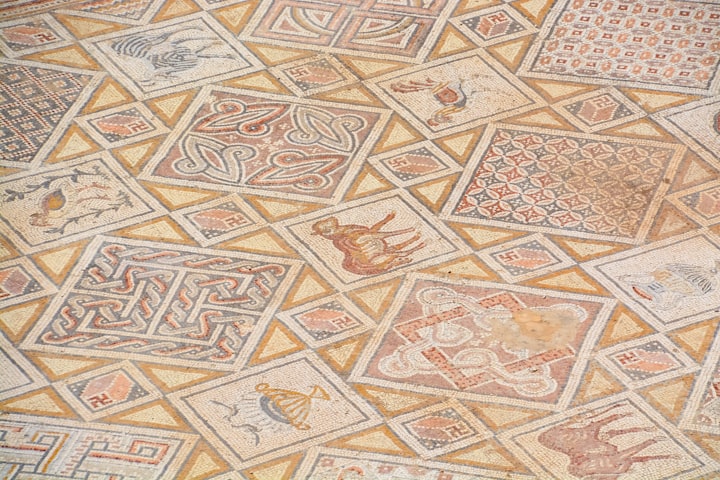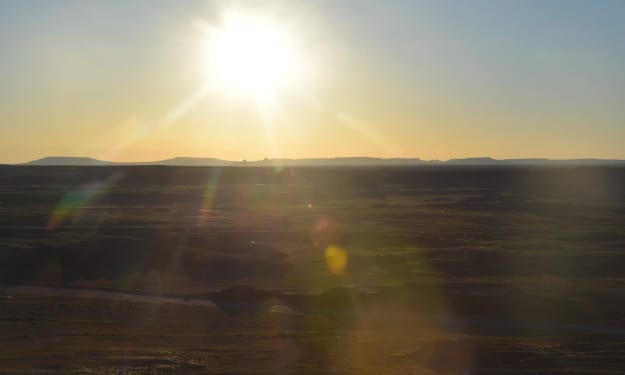The Pavement of the Beit Alfa Synagogue:
A Visual and Iconographic Analysis - Medieval Art


"Little remains of the synagogue building except the floor and walls" of the Beit Alfa Synagogue built during the 6th Century. Complete excavation of the Beit Alfa Synagogue, roughly 90 years ago, revealed the mosaic floor in the central nave, arranged along the length of the floor, depicting the Ark of the Covenant, signs of the zodiac, and the sacrifice of Isaac, the son of Abraham and Sarah from the Old Testament. These images were formed in three separate panels and framed with a mosaic border.



The center panel depicts the Hebrew zodiac with the sun god, Helios, driving his chariot at the center of the zodiac signs. Located at the corners of this panel are four female figures that represent the four seasons.
Located on the north side, the bottom of the mosaic, the third panel is like a storyboard, representing the sacrifice of Isaac referred to as “Akedat Itzchak” (the binding of Isaac). This story reads from right to left, beginning with Abraham holding a knife above his son and ending with the sacrifice of the ram provided by God through his messenger.

Around these three panels are geometric patterns, with paintings of animals, birds, plants, and fruits. Included in the Pavement is "An Aramaic mosaic inscription at the entrance to the synagogue reveals that the floor was laid during the reign of Justinian (apparently Emperor Justinian I). The other inscription, in Greek, mentions the mosaic's artists, Marianus and his son Hanina" (Beit Alfa SYNAGOGUE National Park). The inclusion of this statement establishes the time period of the construction of the synagogue allowing us to compare this work and architecture to other Medieval structures and artwork.

The Beit Alfa SYNAGOGUE National Park has established in situ preservation by enclosing the mosaic and the synagogue remains. Studies have been conducted and information compiled to discuss these preservation efforts. According to Jacques Neguer and Yael Alef in their essay "Managing Sites with Mosaics":
"mosaics in enclosed shelters seem to be in better condition than mosaics in open-sided shelters." The preservation efforts included relaying the Beit Alpha mosaic on cement slabs: allowing the "Beit Alpha mosaic [to remain] in [a] stable condition." This archeological site features the Pavement and representations of the original synagogue showing that "It consists of a courtyard, corridor, rectangular main hall... second-story balcony and another room."
This space is very small, yet it provides the necessary room for worship and placement of the Torah at the front of the Synagogue.
The imagery in this synagogue is important as it establishes the new focus of the Jewish Faith to represent the teachings and traditions in a manner that is recognizable to the larger community. However, as Lawrence Nees points out in Early Medieval Art, the "making of religious art... aroused an aversion;" most likely attributed to the commandment "Thou shalt have no other gods before me."
Like early Christian Art, the images found in the Pavement mosaic depict events, key symbols, and figures. Most significantly, the story-telling aspect of Medieval Art and the sacrifice of Isaac. Nees states that
"The earliest Christian art was not exclusively a system of symbolic signs, for the Christian Bible was a treasure trove of gripping stories that lent themselves to expanded narrative pictures."
In the mosaic at Beit Alfa, the sacrificial story relays the events of that day; Abraham's obedience to God's commands, and the theological context of why this event is important. Isaac and the sacrificial ram represent the realities of sin and death; the need for intervention; and a redeemer who pays for that sin and death. This panel is significant because it stands at the entrance to the liminal space leading to the sacred space through the heavens eventually entering into the presence of God. This movement is representative of both the physical and spiritual journey we each take; thus becoming a reminder to the worshipper who enters into the sacred space.
References:
“Bet Alfa SYNAGOGUE National Park.” Israel Nature and Parks Authoritya, https://www.parks.org.il/en/reserve-park/bet-alpha-synagogue-national-park/.
Britannica, The Editors of Encyclopaedia. "Bet Alfa". Encyclopedia Britannica, 14 Oct. 2011, https://www.britannica.com/place/Bet-Alfa. Accessed 30 September 2021.
Nees, Lawrence. “Earliest Christian Art.” Early Medieval Art, Oxford University Press, Oxford, 2002, pp. 31–45.
Neguer, Jacques, and Yael Alef. “Managing Sites with Mosaics.” Getty: Resources for Visual Art and Cultural Heritage, The Getty, https://www.getty.edu/conservation/publications_resources/pdf_publications/pdf/lessons_parts4_5.pdf.
About the Creator
Rebecca A Hyde Gonzales
I started writing when I was about eight years old. I love to read and I also love to create. As a writer and an artist, I want to share the things that I have learned and experienced. Genres: Fiction, non-fiction, poetry, and history.






Comments
There are no comments for this story
Be the first to respond and start the conversation.